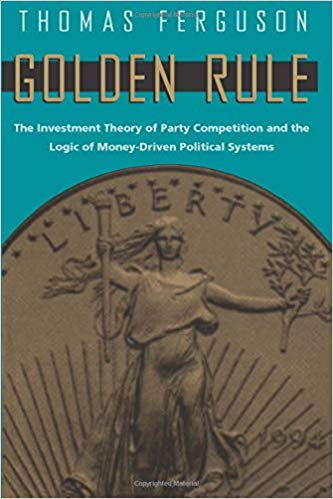
I took some leave from blogging, quite unplanned, but it was a compulsive digression. I have been reading, almost non-stop, book after book and article after article, trying to get a firmer handle on what has been happening to make the world (specifically, our “democracies” in the USA, Europe, Australia) what they are today. I knew something big was changing back in the 1980s and then through the 1990s but you know what it’s like, one is busy getting on with life and carries on like all the other frogs (cooking, washing, driving, working, watching tv) who are in the pot that is slowly coming to a boil.
It all started when someone here posted a video of an interview with Noam Chomsky. I had seen the video before but this time for some reason I took notice when Chomsky directed his interviewer to a study on the influence of corporate dollars on the political system. So I looked it up. It was a book published way back in 1995 by Thomas Ferguson, Golden Rule: The Investment Theory of Party Competition and the Logic of Money-Driven Political Systems.
The central argument of the book is that political parties are not primarily out there trying to win most votes. That’s a secondary exercise and one that falls into place after achieving their first priority: winning the financial backing of whoever can financially back them the most. In its simplest form the idea can be illustrated this way. (I use the issue of unionized labour because that was Ferguson’s illustration; I thought of changing it to the question of carbon emissions and global warming.)
Imagine 97% of the electorate want strong labour unions to ensure job security and fair compensation. These are the ordinary people with only the basic incomes to get by reasonably happy.
Now imagine 3% of the electorate oppose unionization of labour entirely. These are the rich factory owners who employ everyone else.
Election time comes. None of the 97% has the private means, the money, to stand for election. It costs money just to get around from venue to venue and more money to take care of basic income to support one’s family while doing that, etc etc. But one person hits on an idea of how to get money to do everything necessary to campaign for votes. The only people with the money are the 3%. So our would-be candidate asks them to fund the campaign. Some of that 3 % are willing to do so but only on the condition that the candidate promises not to support unionization, but even oppose the idea.
Another would-be candidate finds a few among the 3% who are willing to allow just a small amount of unionization, say for only 5% of the workforce.
Come election day, assuming the two candidates had equal advertizing and equal coverage of the electorate, that is, they each had the same amount of funding, the best that the 97% of the electorate would get out of the election is a representative who will support no more than the unionization of 5% of the workforce. They would not even be likely to get that candidate if he or she only got a fraction of the campaign contributions as their rival.
Obviously real life is more complex than that simplest of models but Ferguson and his colleagues who study the complexities of funding find the rule works essentially every time: to understand who rules look for who has the gold. That’s the golden rule.
Earlier I posted on what I believed to be an insightful article by Nancy Fraser, From Progressive Neoliberalism to Trump — and Beyond. Thomas Ferguson’s work is coming from the same direction. But Golden Rule is old. Published 1995. So I looked for more recent work. And that’s where I’ve been the past several days, reading and following up more recent studies by Ferguson and by others he cites and others who appear to be working from the same datasets of evidence.
The most dramatic shifts have happened with the emergence of Bernie Sanders and Donald Trump, of course, and that’s where I have been trying to catch up with. What the hell is going on? It’s not completely alien to human experience, though. One recent study even sent me back to reading the 1973 edition of Hannah Arendt’s The Origins of Totalitarianism (first published 1948). (That was to revisit other historical alliances of what Arendt calls “the alliance between mob and capital”.)
It’s been a fascinating, though troubling, journey, covering shifts and divisions in the corporate class, propaganda manipulations, and, I think, a deeper understanding of how this complex and confusing world works. Once again one finds scholarly research tackling questions that have traditionally been forbidden in their field and the need for those pioneers to branch out into interdisciplinary studies before eventually making significant inroads into the conventional wisdom.
I expect to be posting more along the lines of these sorts of studies.

